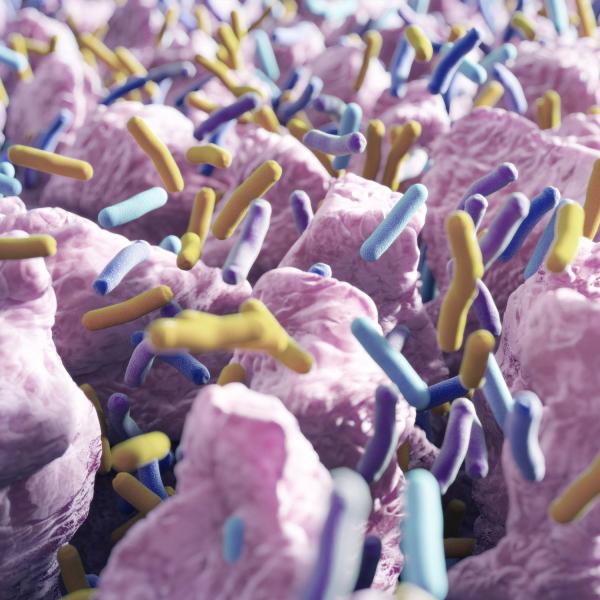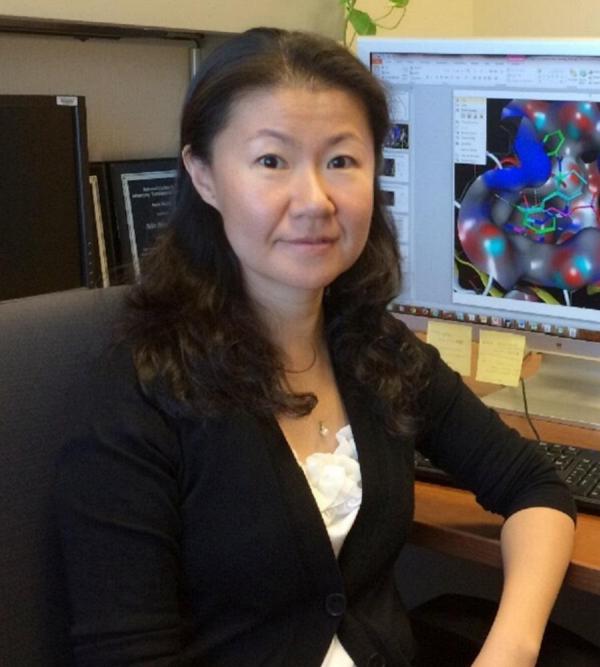A Computational Approach to Curbing Chemotherapy’s Side Effects
Study Identifies Compounds That Could Aid Body’s Removal of Toxic Cancer Drugs

IRP researchers used NIH’s supercomputer to virtually screen a huge number of compounds to find ones that could help curb the side effects of cancer chemotherapy.
When it comes to cancer, the treatment can sometimes feel worse than the disease. Not only do chemotherapy drugs cause grueling side effects, but certain products made by otherwise benign bacteria living in our digestive system can interfere with the body’s ability to get rid of those toxic chemicals. A new IRP study used a cutting-edge computational approach to help identify compounds that inhibit one of those meddling bacterial molecules, which could eventually lead to the creation of medications that reduce some of chemotherapy’s side effects.1
In recent years, a huge amount of research and press coverage has focused on how the bacteria that live in and on us help keep us healthy. However, just because our bodies generally live in harmony with these bacteria doesn’t mean they always have our best interests at heart.
Case in point: the body converts many chemotherapy drugs into an inactive form by attaching a small sugar molecule to them. This allows the drugs to move through the intestines and out of the body. However, some species of bacteria that live in our intestines make an enzyme, called beta-glucuronidase, that removes that sugar molecule from the chemotherapy drug. Newly freed from its chemical chains, the chemotherapy drug can resume wreaking havoc in the digestive system, leading to diarrhea that can be so severe it sends patients to the hospital.
“Many people can’t tolerate the side effects and can’t complete the full course of their chemotherapy,” says Min Shen, Ph.D., who leads the Informatics group in the Division of Preclinical Innovation at NIH’s National Center for Advancing Translational Sciences (NCATS). “Normally, chemotherapy will be administered multiple times, but many people quit in the middle.”

Beta-glucuronidase enzymes are produced by the resident bacteria living in our intestines.
Obviously, quitting chemotherapy or lowering the dose to reduce side effects is not good for the long-term health of cancer patients. That’s why Dr. Shen’s team is trying to find molecules that can inhibit the bacterial beta-glucuronidase enzymes that exacerbate chemotherapy’s side effects.
“So far, there’s no FDA-approved product to prevent this chemotherapy-induced diarrhea,” Dr. Shen says. “We want to help the patients complete the full course of their chemotherapy, and we also want to reduce costs associated with hospitalization.”
Unfortunately, using antibiotics is a less-than-ideal solution for this problem because they kill beneficial bacteria along with those that produce beta-glucuronidase, and their use contributes to the rise of dangerous antibiotic-resistant bacteria as well. Instead, with the help of NIH’s Biowulf supercomputer, Dr. Shen’s team ran a ‘virtual high-throughput screen’ to simulate the ability of nearly 400,000 different compounds to inhibit beta-glucuronidase.
Since the three-dimensional structure of that particular bacterial enzyme has not been determined yet, Dr. Shen’s team first had to build a virtual model of it using information gleaned from the known molecular structures of similar enzymes produced by other species of bacteria. Next, the scientists used Biowulf to simulate molecular interactions between the virtual model of beta-glucuronidase and the hundreds of thousands of compounds they screened, which included FDA-approved medications as well molecules with known three-dimensional structures but no current medical uses.
“In simple terms, this is really just considering how well your molecule fits into the enzyme’s binding pocket,” Dr. Shen explains. “It depends on the size, the shape, and the orientation of the molecule, and also specific molecular interactions. It’s like a lock and key — if the key is too big, it cannot fit into this pocket, and if it has a different orientation, it also can’t fit into the pocket.”

NIH’s supercomputer, Biowulf, is made up of so many processing cores that they take up their own building.
From the nearly 400,000 compounds the study began with, the virtual screen flagged 2,500 that it predicted might be able to inhibit the beta-glucuronidase enzyme. Then, Dr. Shen and her colleagues took over, using their expertise to eliminate candidates with undesirable traits and select 291 compounds to mix with beta-glucuronidase in the lab. Those follow-up tests identified 69 molecules that did a good job of inhibiting beta-glucuronidase, including 13 that were particularly effective.
“I think the major benefit of using this sort of computational approach is saving time and resources,” Dr. Shen says. “Here at NCATS, we’re doing this research to try and speed up the drug discovery process. That is the one bottleneck we face every day — screening a huge chemical library can take months or years, but using computational approaches, we can do this virtual screening in days or even hours in some cases.”

Dr. Min Shen
Eventually, one of the compounds Dr. Shen’s study identified could be developed into a medication that cancer patients can take to alleviate digestive problems caused by their chemotherapy regimens. Before that can happen, though, Dr. Shen’s team must conduct further testing, as well as work with chemists at NCATS to tweak the compounds in ways that might improve their effectiveness as drugs. Dr. Shen or other researchers may also screen more compounds using the same computational approach to see if they can find other beta-glucuronidase inhibitors that are more potent or have other desirable properties.
“The diversity of chemical libraries has increased dramatically — there are libraries that have billions of compounds to screen,” Dr. Shen says. “In the past, doing that was virtually impossible because you didn’t have the computational power or even the storage space for all these molecules. But now with the cloud and all the computational power available, this virtual screening approach will be used more and more to do drug discovery.”
Subscribe to our weekly newsletter to stay up-to-date on the latest breakthroughs in the NIH Intramural Research Program.
References:
[1] Challa AP, Hu X, Zhang Y, Hymes J, Wallace BD, Karavadhi S, Sun H, Patnaik S, Hall MD, Shen M. Virtual Screening for the Discovery of Microbiome β-Glucuronidase Inhibitors to Alleviate Cancer Drug Toxicity. J Chem Info Model. 2022 Apr 11;62(7):1783-1793. doi: 10.1021/acs.jcim.1c01414.
Related Blog Posts
This page was last updated on Wednesday, May 24, 2023
